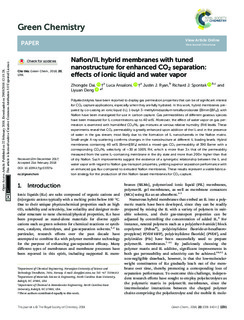| dc.contributor.author | Dai, Zhongde | |
| dc.contributor.author | Ansaloni, Luca | |
| dc.contributor.author | Ryan, Justin J. | |
| dc.contributor.author | Spontak, Richard J | |
| dc.contributor.author | Deng, Liyuan | |
| dc.date.accessioned | 2019-03-20T15:41:47Z | |
| dc.date.available | 2019-03-20T15:41:47Z | |
| dc.date.created | 2018-03-05T17:26:21Z | |
| dc.date.issued | 2018 | |
| dc.identifier.citation | Green Chemistry. 2018, 20 (6), 1391-1404. | nb_NO |
| dc.identifier.issn | 1463-9262 | |
| dc.identifier.uri | http://hdl.handle.net/11250/2590941 | |
| dc.description.abstract | Polyelectrolytes have been reported to display gas permeation properties that can be of significant interest for CO2 capture applications, especially when they are fully hydrated. In this work, hybrid membranes prepared by co-casting an ionic liquid (IL), 1-butyl-3-methylimidazolium tetrafluoroborate ([Bmim][BF4]), with Nafion have been investigated for use in carbon capture. Gas permeabilities of different gaseous species have been measured for IL concentrations up to 40 wt%. Moreover, the effect of water vapor on gas permeation is examined with humidified CO2/N2 gas mixtures at various relative humidity (RH) levels. These experiments reveal that CO2 permeability is greatly enhanced upon addition of the IL and in the presence of water in the gas stream, most likely due to the formation of IL nanochannels in the Nafion matrix. Small-angle X-ray scattering confirms changes in the nanostructure at different IL loading levels. Hybrid membranes containing 40 wt% [Bmim][BF4] exhibit a mixed-gas CO2 permeability of 390 Barrer with a corresponding CO2/N2 selectivity of ∼30 at 100% RH, which is more than 3× that of the permeability measured from the same IL-containing membrane in the dry state and more than 200× higher than that of dry Nafion. Such improvements suggest the existence of a synergetic relationship between the IL and water vapor with regard to Nafion gas-transport properties, yielding superior separation performance with an enhanced gas flux compared to extruded Nafion membranes. These results represent a viable fabrication strategy for the production of thin Nafion-based membranes for CO2 capture. | nb_NO |
| dc.language.iso | eng | nb_NO |
| dc.publisher | Royal Society of Chemistry | nb_NO |
| dc.rights | Navngivelse 4.0 Internasjonal | * |
| dc.rights.uri | http://creativecommons.org/licenses/by/4.0/deed.no | * |
| dc.title | Nafion/IL hybrid membranes with tuned nanostructure for enhanced CO2 separation: effects of ionic liquid and water vapor | nb_NO |
| dc.type | Journal article | nb_NO |
| dc.type | Peer reviewed | nb_NO |
| dc.description.version | publishedVersion | nb_NO |
| dc.source.pagenumber | 1391-1404 | nb_NO |
| dc.source.volume | 20 | nb_NO |
| dc.source.journal | Green Chemistry | nb_NO |
| dc.source.issue | 6 | nb_NO |
| dc.identifier.doi | 10.1039/c7gc03727a | |
| dc.identifier.cristin | 1570581 | |
| dc.relation.project | EC/FP7/608555 | nb_NO |
| dc.description.localcode | This article is licensed under a Creative Commons Attribution 3.0 Unported Licence. | nb_NO |
| cristin.unitcode | 194,66,30,0 | |
| cristin.unitname | Institutt for kjemisk prosessteknologi | |
| cristin.ispublished | true | |
| cristin.fulltext | original | |
| cristin.qualitycode | 1 | |

